Localities of the Eocene:
The Florissant Formation
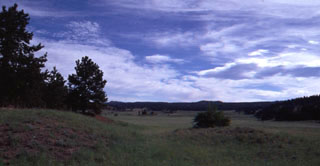


This pleasant green valley, set in the eastern Rocky Mountains of Colorado not far from Pikes Peak, is the site of an important fossil deposit that provides a look at life in the late Eocene. Thirty-six million years ago, volcanic mudflows blocked a stream flowing through this valley, producing a lake about twelve miles long. Vegetation flourished on the shores of this lake, and the valley came to teem with life, until about two million years later. At that time, about thirty-four million years ago, a new series of periodic volcanic eruptions began about fifteen miles away, in what is now South Park, Colorado. These eruptions spewed out fine-grained volcanic ash (much like the ash spewed out by Mount St. Helens in 1980), which choked and eventually filled in the ancient lake and valley. The fine ash rapidly buried countless plants, insects, snails, and other animals, preserving them beautifully in the process.
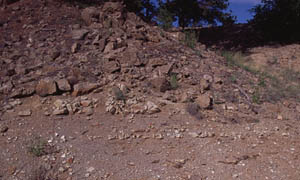
Today, these ancient ashfalls are named the Florissant Formation, after the Florissant Valley and the nearby town of Florissant. Tens of thousands of fossils from the Florissant Formation have been collected and studied since the late 19th century; they can be found today in museums around the world. Most of the Florissant beds are protected by the Federal Government, making up Florissant Fossil Beds National Monument. Some private quarries do exist in the area where the general public can collect fossils.
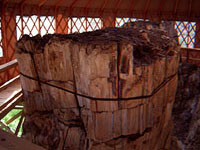
|
Petrified Redwood Stumps: The fossilization process known as petrifaction usually begins when a tree or log is buried in silica-rich, alkaline volcanic ash or mud. Water seeping through the ash or mud dissolves silica. If silica-rich water soaks into a buried piece of wood, where conditions are more acidic, silica is precipitated inside the hollow cells of the wood. This is what happened to these huge tree stumps, which have been identified as Sequoia trees. Before the Florissant beds received Federal protection, several redwood stumps were destroyed or damaged by souvenir seekers and collectors. In 1904, the citizens of Florissant attempted to saw one of the largest stumps in half so that it could be exhibited at the Chicago World's Fair. Fortunately, two attempts to saw the stump break the sawblades before serious damage was done, and the plan was abandoned. Today, metal cables wrapped around the crumbling stumps protect them from falling apart. |
|
Florissant Plants: By far the most common fossils in the Florissant beds are leaves and other plant remains. The left image shows a Sequoia leaf, probably belonging to the same species as the giant tree stumps. To the right is an image of a leaf of Cercocarpus, or mountain mahogany. These are just two of over 140 plant species that have been collected from the Florissant beds. The Florissant flora includes several plants that are very rare in the fossil record, such as mosses, however it is dominated by conifers and dicot (broad-leaved) angiosperms. Some of the plants lived in or very near the water, such as cattails and willows; others probably grew in different habitats, but wind-blown leaves were buried in ash with the rest of the plants. The most common forms included beech-like trees, poplars, willows, cattails, sumac, soapberry, and conifers such as pines, sequoias, and false cypress. In general, the flora is quite similar to the flora of the slightly older Green River Formation of Wyoming, eastern Utah, and western Colorado. As in the Green River flora, several of the Florissant fossil plants belong to taxa that are no longer present in Colorado, or even in North America. Sequoia today is found only in the Pacific Northwest; Koelreuteria (raintree) is restricted to eastern Asia today; and Ailanthus (tree-of-heaven) is also native only to eastern Asia now, but has recently become naturalized in eastern North America. |
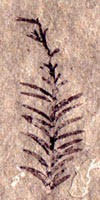
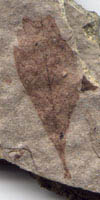
|
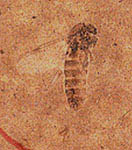
|
Florissant Insects: This fly demonstrates just how good the preservation of delicate organisms can be. Flies are common in the Florissant Formation, including members of at least two dozen families. Most abundant are flies in the Bibionidae (March flies), Empididae (danceflies) and Nemestrinidae (tangle-winged flies). Also present are flies in the family Glossinidae -- the infamous tsetse flies, notorious today as carriers of African sleeping sickess, and found only in sub-Saharan Africa today. The Florissant Formation has also yielded true bugs, dragonflies, and the oldest true butterflies so far known, preserved so well that even the color patterns can be seen. |
|
Other Florissant Animals: Only about five millimeters across, this flattened snail shell is a reminder that other kinds of animals besides insects once lived in the ancient lake and valley. In addition to snails, vertebrates have been found in the Florissant beds, although they are quite rare. Vertebrates of the Florissant include several species of birds and fish, as well as mammals such as small, three-toed horses, possum-like marsupials, and pig-like mammals known as oreodonts. |
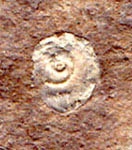
|
For more information visit the Florissant Fossil Beds National Monument site maintained by the National Park Service. The "Fascinating Fossils" slide show includes pictures of some of the best Florissant fossils, such as this butterfly. Well worth a visit, the Monument preserves historic homesteads and wildlife habitat, as well as fossils and fossil exhibits. And the diner in the town of Florissant serves tasty breakfasts.
Also see the "Catalog of the Fossil Flies of the World", by Neal Evenhuis, for more information on fossil flies in general.

Sources:
MacGinitie, H. D. 1953. Fossil plants of the Florissant Beds, Colorado.
Carnegie Institution of Washington Contributions to Paleontology, 559:
1-198.

